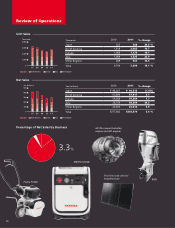Honda 2011 Annual Report Download - page 31
Download and view the complete annual report
Please find page 31 of the 2011 Honda annual report below. You can navigate through the pages in the report by either clicking on the pages listed below, or by using the keyword search tool below to find specific information within the annual report.To support the sale of its products, Honda provides retail lending
and leasing to customers and wholesale financing to dealers
through our finance subsidiaries in Japan, the United States,
Canada, the United Kingdom, Germany, Brazil, Thailand and
other countries.
The total amount of finance subsidiaries–receivables and
property on operating leases of finance subsidiaries increased
by ¥67.9 billion, or 1.4%, to ¥4,837.6 billion from the previous
fiscal year, due mainly to an increase of finance subsidiaries–
receivables attributable to the adoption of new accounting
standards, which was partially offset by the negative foreign
currency translation effects. Honda estimates that by applying
the Japanese yen exchange rates of the previous fiscal year to
the current fiscal year, the total amount of finance subsidiaries–
receivables and property on operating leases of finance sub-
sidiaries as of the end of the year would have increased by ap-
proximately ¥595.9 billion, or 12.5%, compared to the increase
as reported of ¥67.9 billion, which includes the negative foreign
currency translation effects.
Revenue from external customers in the financial services
business decreased ¥44.4 billion, or 7.3%, to ¥561.8 billion
from the previous fiscal year. Honda estimates that by apply-
ing the Japanese yen exchange rates of the previous fiscal year
to the current fiscal year, revenue for the year would have de-
creased by approximately ¥1.2 billion, or 0.2%, compared to
the decrease as reported of ¥44.4 billion, which includes the
unfavorable foreign currency translation effects. Revenue in-
cluding intersegment sales decreased ¥45.3 billion, or 7.3%, to
¥573.4 billion from the previous fiscal year.
Operating costs and expenses decreased ¥36.7 billion, or
8.7%, to ¥387.1 billion from the previous fiscal year. Cost of
sales decreased ¥11.6 billion, or 3.6%, to ¥309.8 billion from
the previous fiscal year, due mainly to a decrease in costs related
to lease residual values. Selling, general and administrative ex-
penses decreased ¥25.0 billion, or 24.5%, to ¥77.3 billion from
the previous fiscal year, due mainly to a decrease in provisions
for credit losses.
Operating income decreased ¥8.6 billion, or 4.4%, to ¥186.2
billion from the previous fiscal year, due mainly to unfavorable
foreign currency effects, which was partially offset by a decrease
in provisions for credit losses and losses on lease residual values.
Our finance subsidiaries in North America have historically
accounted for all leases as direct financing leases. However,
starting in the fiscal year ended March 31, 2007, some of the
leases that do not qualify for direct financing leases account-
ing treatment are accounted for as operating leases. Generally,
direct financing lease revenues and interest income consist of
the recognition of finance lease revenue at the inception of the
lease arrangement and subsequent recognition of the interest
income component of total lease payments using the effective
interest method. In comparison, operating lease revenues in-
clude the recognition of the gross lease payment amounts on
a straight-line basis over the term of the lease arrangement,
and operating lease vehicles are depreciated to their estimated
residual value on a straight-line basis over the term of the lease.
It is not anticipated that the differences in accounting for oper-
ating leases and direct financing leases will have a material net
impact on Honda’s results of operations overall, however, oper-
ating lease revenues and the associated depreciation of leased
assets do result in differing presentations and timings compared
to those of direct financing leases.
Honda consolidated former qualifying special-purpose enti-
ties (QSPEs) that were not consolidated as of March 31, 2010.
As a result, previously derecognized finance subsidiaries–receiv-
ables held by former QSPEs increased in the Company’s consoli-
dated balance sheet as of April 1, 2010. In addition, Honda is
not recognizing certain gains or losses related to securitization
transactions, such as gains or losses attributable to the change
in the fair value of retained interests since the year ended March
31, 2011.
Financial Services Business
29
























